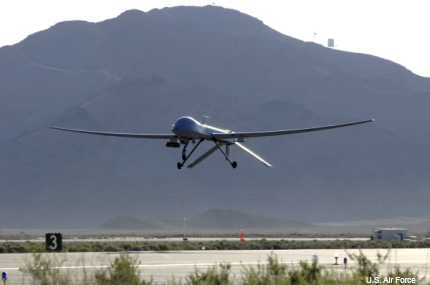Pentagon plans to boost drone flights by 50 percent
DOD will supplement Air Force crews with Army, Special Forces and contractor teams to cover more territory, a Wall Street Journal reports says.

Less than a year after announcing plans to reduce the number of drone flights—mostly due to a shortage of pilots—the Pentagon now plans to increase the number of unmanned flights by 50 percent over the next four years, according to a report in the Wall Street Journal.
A senior defense official told the Journal the plan is to expand drone flights—and the intelligence and strike capability they provide—in global hot spots such as Iraq, Syria, the South China Sea and North Africa. To accommodate the increase, the Defense Department plans to make greater use of the Army, Special Operations Command and contractors in conducting the flights, the report said. To date, the Air Force has handled the majority of unmanned operations involving large, long-range aircraft such as the MQ-1 Predator and MQ-9 Reaper.
The Air Force has been wrestling with a shortage of pilots for unmanned aerial systems for years, with crews complaining of being overworked and unrewarded. As of early this year, the Air Force was maintaining 65 combat air patrols, or CAPs, each of which provide 24-hour coverage of an area and involve four MQ-1 Predator or MQ-9 Reaper UAS along with pilots and other associated ground crews.
In 2014, with the drawdown in Iraq and Afghanistan, DOD in its Quadrennial Defense Review announced plans to cut the number of CAPs to 55. The rise of ISIS in Iraq and Syria changed those plans, though not the budget—the Air Force currently has 61 CAPs, albeit with the budget and resources for 55.
According to the report in the Journal, the new plan calls for as many as 90 CAPs by 2019. The defense official said that, by 2019, the Air Force would be flying 60 CAPs a day, the Army up to 16 and Special Forces as many as four. As well, contractors would contribute up to 10 flights a day with older Predators, although they would be strictly surveillance flights, with no strike capability.
Recruiting and retaining drone pilots has been a challenge for the military, for a variety of reasons. For one, the work often is seen as drudgery, filled with long uneventful spells. And no matter the importance of a mission, it doesn’t have the appeal of flying manned aircraft. Nor has it has the rewards—studies have shown that UAS pilots are promoted at a lower rate than manned-aircraft pilots and that they burn out and quit at three times the rate.
The Air Force has this year taken steps to address the problem, announcing increases in pay, $15,000-a-year bonuses for retention--in line with what manned-aircraft pilots get—and efforts to reduce the load on pilots by, among other things, making greater use of Reserve and National Guard forces.